Self massage for high blood pressure
Trigger point therapy is not only good for fibromyalgia, scientists have found that trigger points are the main cause of fibromyalgia and... Read Article
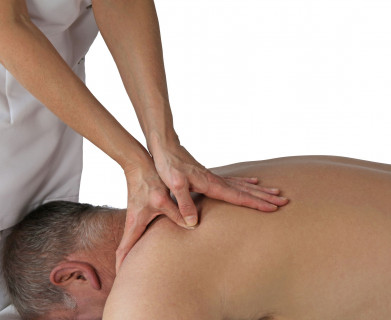
Trigger point therapy is not only good for fibromyalgia, scientists have found that trigger points are the main cause of fibromyalgia and treating them should be the first thing considered.
In this article we will go over why trigger points are the major cause of fibromyalgia, then discuss your best treatment options, including home trigger point therapy
What are trigger points
How treating trigger points helps fibromyalgia
How to treat your trigger points for fibromyalgia
Your home trigger point therapy options
Professionals
Appendix: summary of the clinical trials of massage for fibromyalgia
Appendix: what the research says about individual trigger point therapies
References
Trigger points are those tender lumps in your muscles that therapists find. For more information on them please see our article trigger point basics
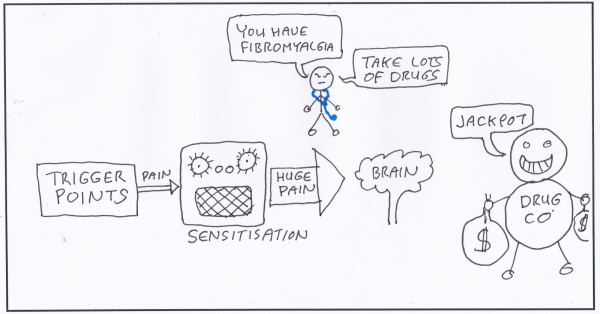
Scientists have found that fibromyalgia is usually caused by your nervous system being bombarded by pain over long periods of time until it becomes sensitised. When sensitised it acts like an amplifier, making normal stimuli painful and pain to be much worse.
The biggest source of this bombarding pain is trigger points. This is because they are arguably the largest cause of musculoskeletal pain such as back, neck and shoulder pain, yet are often not diagnosed or poorly treated. Please see our article How scientists have sucessfully treated fibromyalgia for more details.
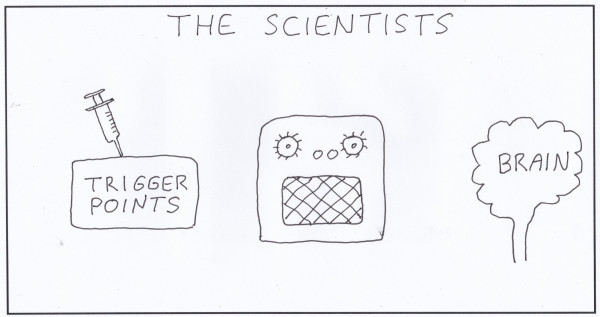
Knowing fibromyalgia is usually caused by continual bombardment with pain, the logical treatment is to stop that pain. Scientists did this. They stopped the trigger point pain by injecting the trigger points with anaesthetic (1). This not only relieved the pain from trigger points, it relieved fibromyalgia symptoms across the whole body. Knowing this, scientists recommended that the first thing to do when someone has fibromyalgia is to find and treat the trigger points.
Injecting trigger points like the scientists did is a great way to prove that trigger points are the main cause of fibromyalgia, but it’s not practical to give sufferers multiple injections each day. Instead we need to actually eliminate the trigger points themselves. We’ll show you how to do this in the next section.
Self massage is an important part of your overall strategy to treat fibromyalgia causing trigger points. Before reading the complete strategy below we have a quick overview video.
There are three basic things we need to consider to successfully treat your trigger points.
Therapies are things like massage, laser, needles and vibration massage. Therapies are very important, but trigger points are usually part of a more complex musculoskeletal problem, plus there are usually things that cause or aggravate them. You’ll need some professional advice to help handle these other things.
As discussed in our article Why trigger points keep coming back courses of trigger point therapy usually just relieve their pain, not get rid of the problem. To properly get rid of trigger points you will need to continue with those therapies over a long period of time, so the trigger points will continue to diminish and hopefully go altogether. Of course this will need a very large number of applications, which is why we provide our home therapy solutions. Otherwise, it will be very expensive and time consuming. To give you an idea of just how many applications of professional therapy are needed the following two appendices show what is typically used just to get temporary pain relief.
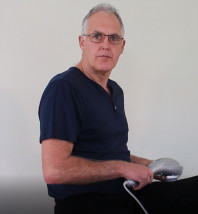
I’m now going to share with you the best way to deal with trigger points of fibromyalgia properly, but in a way that is not horrendously expensive or time consuming. You will need some professional advice as just discussed, but the bulk of what you need will be trigger point therapy. If you can do a lot of that yourself at home you can make this very effective strategy very affordable.
What usually happens when you get professional help for trigger points is you see a professional and he or she spends most of their time applying massage, needles or whatever. As discussed, to properly deal with your trigger points you will need a large number of applications of therapy so this will become very expensive very fast, and as discussed in Why trigger point pain keeps coming back all you’ll likely get is temporary pain relief.
Instead you use your professional’s time to do things like check you for bio-mechanical problems, doing some detective work to find the causes, and provide general management advice. You find a qualified professionals and discuss that as part of your management you will be doing a lot of the therapy yourself at home using one of the very effective home therapies we’re about to share.
You’ll need to find an appropriate professional. I’m a Chiropractor. My colleagues and I spent five years in university learning about all those extra things, but there are also other professions. If your don't have a professional a good place to start would be the clinics that use and recommend our massagers. Go to our order page, select your country, the the clinic option.
There are two basic types of trigger point therapy you can use at home: those based on manual massage techniques and those using vibration massage. In this section we’ll show you how to find your trigger points and how to do both of these therapies.
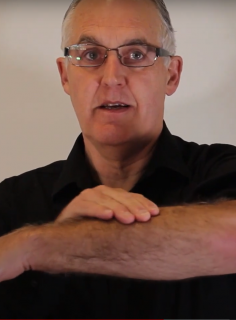
Trigger points are tender lumps within tight bands of muscle. When you press on them they will shoot pain and sometimes cause the muscle to twitch. We thoroughly recommend that you consult a professional who deals with trigger points to help identify the ones affecting you and show you how to find them, but we share with you the basic examination procedure. These are demonstrated in our video on treating forearm muscles
Gently press on the muscle with flat fingers, examining for areas of general tightness and tenderness. When found, use one or two fingers to explore more deeply for tightness and a tender lump.
Manual massage techniques performed by professional therapist can be an effective trigger point therapy. There are home techniques that mimic these. As we discuss in our article Do foam rollers work we have reservations about the use of tools such as balls and foam rollers to apply painful pressure, but will show you two relatively safe and effective techniques.
One of main massage techniques is called “stripping” (technical name= effleurage). Think of gradually moving along the muscle like squeezing out an old sponge. To do this lubricate your skin, apply moderate pressure and move along the muscle slowly. As the veins and lymphatic vessels have one way valves this needs to be done towards your heart.
To turn this stripping technique into a very effective trigger point therapy, when you get to a tight spot or trigger point stop and hold the pressure for 5-10 seconds, then slowly move on. The safest and best way to do this technique is to start with light to moderate pressure then gradually repeat with more pressure. For a demonstration of this please see our video on treating forearm muscles
Professional therapists use various techniques that apply pressure direct to the trigger point. There are a lot of people advising to do this at home with balls and rollers. As discussed though we have reservations about the risks and benefits of doing this. In clinic we have seen seen way to many patients hurt themselves and get very little benefit. However, there is a very safe and effective way to use pressure techniques at home. In a trial of a traditional Thai home massage (2) a special tool with a long handle was used to apply moderate pressure to relaxed muscles. Each day each trigger point was given five applications of this moderate pressure for five seconds each. This tells us painful pressure is not needed. Multiple applications of moderate safe pressure work very well.
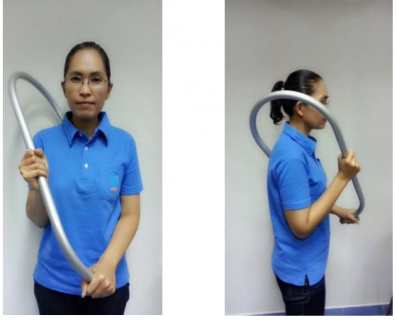
Safe and effective Thai technique
Using the tool allowed the muscles treated to be relaxed. 5 seconds of moderate pressure pressure was applied five times. This was repeated each day. To use this technique find each trigger point, make sure the muscle is relaxed, then use either your hands or some sort of tool to give multiple applications of moderate pressure.
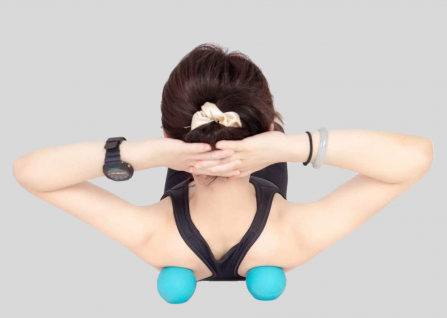
Ball and roller techniques
For comparison this picture shows applying pressure to the same muscles using a ball. Note that the muscles are far from relaxed, and being an awkward position it would be far harder to control the pressure.
Vibration massage is widely used by professionals to treat trigger points. It is done by simply placing the vibration massager over the trigger point allowing the vibrations to penetrate and have their effect. Because it does not require penetrating pressure it is relatively safe, and because no special skills are required it is far easier to self apply.
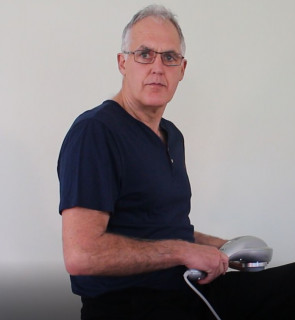
Manual therapies rely on skilled application and it can be difficult to get into some positions for self massage, so self applied manual massage is often no where as effective as professional therapy. On the other hand because a vibration massager just sits on the surface and does the work, as long as it is applied in the right place self applied vibration massage can be as effective and professionally applied vibration.
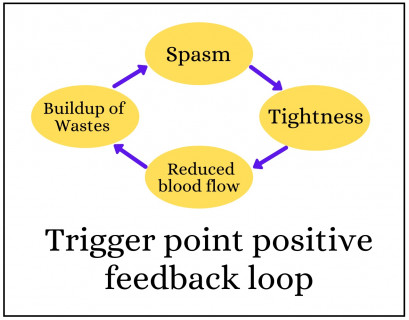
As shown in this diagram the key parts of a trigger point are muscle spasm, muscle tightness, restricted blood flow, and a build up of toxic wastes. Vibrations have been shown to help all of these. For more information please see our guide The scientifically proven effects of vibration massage- with clinical applications.
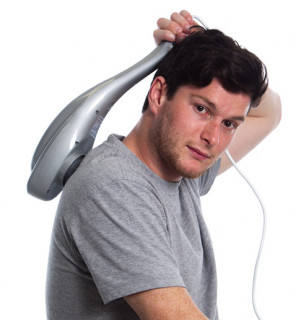
Using vibration massage is extra-ordinarily easy. We ask you to check our our instructions for the fine points and precautions, but basically all you need to do is place the vibration massager on the muscle over the trigger point and let the vibrations penetrate for 30-60 seconds. This can easily be repeated every day.
For how to choose an quality massager that will do a great job and that you will be extremely happy with please see our article How to choose a massager, or you can go straight and check out our economical, easy to use professional standard machines: the General Purpose Massager or our Ultimate Quad Head Massager.
Please continue these therapies after your pain has gone
Most people just use these therapies for pain relief, but as discussed in our article Why trigger point pain keeps coming back trigger points don’t go so the pain returns. However, if you continue using regular trigger point therapy after the pain goes it will continue to diminish the trigger points and you will be much better off than those who just do pain relief.
If you found this useful please check out our other self massage and trigger point therapy articles.

If you are a professional wishing to help your patients/clients with home trigger poing therapy DrGraeme massagers were originally built by Dr Graeme for use in his clinic for this purpose and are now used by colleagues and other professionals for similar purposes. If you are a professional and wish to know more about this therapy, or possibly get a sample massager to trial please check out our practitioner page.
Trial |
Type of massage |
Duration, frequency, number |
Outcome |
|---|---|---|---|
Friction massage vs stretching vs analgesics |
Uncertain |
Friction massage not beneficial. Friction massage is a painful massage not suited for trigger points |
|
Compared Swedish massage with TENS machine |
Ten 30 minute sessions @ 2 per week |
Massage resulted in less pain, less fatigue, better sleep and lower anxiety |
|
Connective tissue massage |
15 sessions @ 1.5 per week |
Massage gives pain relief, relieved anxiety and improved quality of life. After treatments finished improvements gradually diminished over 6 months |
|
Swedish massage compared with standard physician care |
Ten sessions over 24 weeks |
Massage showed improvement, but only small numbers in trial |
|
Combination of styles |
30 minutes, twice a week for 5 weeks |
Less, pain, less anxiety and better sleep |
|
Myofascial release massage |
Weekly 90 minute session for 20 weeks |
Improved pain and quality of life |
|
Myofascial release |
Ten 60 minute sessions over 20 weeks |
Less tender spots, improved physical function |
|
Swedish massage vs myofascial release |
90 minute session weekly for 4 weeks |
Both produced pain reduction and improved movement. Myofascial release had better results |
|
Full body Shiatsu |
Sixteen 40 minute sessions @ twice a week |
Improved pain, tenderness and sleep |
|
Mechanical massage device called Cellu M6 |
Fifteen weekly 35 minute sessions |
Improved pain and function, and reduced number of trigger points |
Below is a summary of the findings of several scientific reviews of trigger point therapies (3-9).
As said previously, the goal of trigger point therapy, according to the scientists, is to deactivate the trigger points. None mention having the goal of eliminating trigger points.
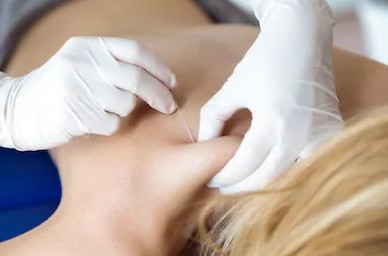
Most trials show that dry needling provides some short term pain relief and improved function. The risks and potential to cause pain are obvious. The mode of how needles work is still speculation. Where dry needling had been compared with laser the laser has given slightly better results.
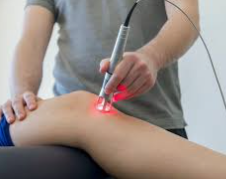
Trial results for laser have been marginally better than those for dry needling, but still only temporary relief. Scientists attribute it’s effect to increasing micro-circulation, improving oxygenation and helping remove waste products. However, this is something that can easily be achieved, if not better, by any competent massage therapist.
The big concern with laser is the sheer number of applications of therapy sessions needed for only temporary benefits. For example one trial (10) used 10 daily applications of laser on patients with upper back and neck pain to get a reduction in pain and tenderness for three weeks. Further, according to one review (22) applications of laser should be given from 2-3 times a week though to 5 times a week, with a total of 30 applications of therapy for long term cases. Keep in mind this is just to achieve deactivation, not to eliminate the problem. Assuming each laser consultation costs $50 and takes an hour out of your day that’s $1,500 and 30 hours of your life just for some temporary pain relief, leaving you to front up again next time the problem is aggravated.
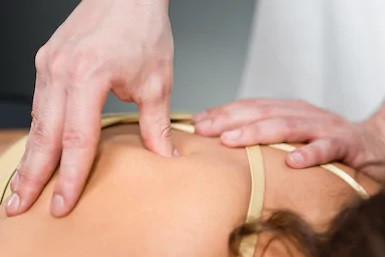
There are various types of manual therapies that involve pressure, massage and stretching of muscles. The trial results for them tend to be similar to those of laser and dry needling. However, according to one review (4) one study did show residual benefit after six months.
We are continually adding more information on research and uses. Subscribe below to have us email them to you "hot off the press".

Several years ago Dr Graeme, a Chiropractor practicing in Victoria, Australia was looking for a serious hand held massager his patients could use at home to get the extra quality massage they needed. The ones he found in the shops and on-line for home use looked nice but were not serious, and... read more
Trigger point therapy is not only good for fibromyalgia, scientists have found that trigger points are the main cause of fibromyalgia and... Read Article
Massage guns are heavily marketed as a substitute for professional therapists, providing benefits such as sports recovery and pain... Read Article
Yes (myofascial) trigger points are a very large cause of shoulder pain. They have been found to be extremely common in sufferers of... Read Article
Tension headaches often mean a life of suffering and symptom relieving drugs, but a clinical trial showed that simple trigger point... Read Article
Professional sports clubs have long used massage as a way to help their athletes, and more recently various self massage options have... Read Article
Vibration massage is an excellent therapy. However, too many massage guns fail to deliver this because: they use percussion which is less... Read Article
Treating or releasing trigger points yourself is actually extremely easy. With a bit of instruction and practice you can easily find the... Read Article
Muscular problems including trigger points have been shown to be a major cause of calf pain, with massage and trigger point therapy... Read Article
Do not refresh or leave this page until loading complete.